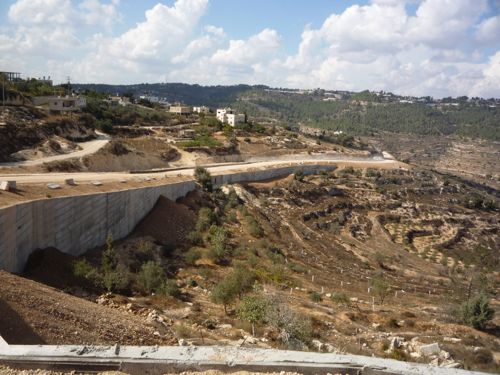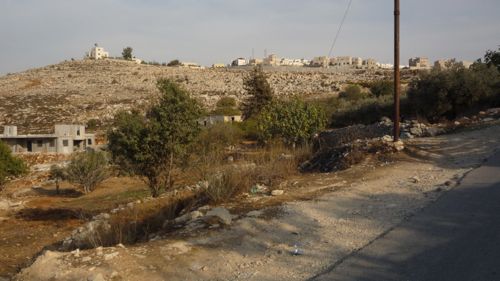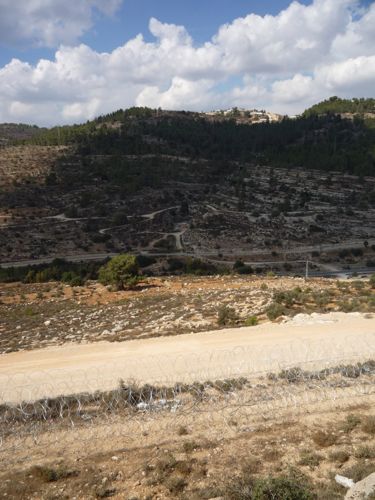The village of Walaja (pronoumnced Wa-le-jay) is located on the southern border between Jerusalem and the West Bank. About a third of the village's land is located within the boundaries of the Jerusalem municipality (since the annexation of East Jerusalem in 1967). (see map)
Since the early 2000's Israel has been planning to lay a Separation Barrier (sometimes called Security {or Apartheid} Wall {or Fence}). A lot of the reasons for needing or wanting a wall by Israel were formed during the second intifada, when suicide bombings were more frequent. The situation in Israel is quite different today, yet it is today that the barrier is reaching near completion around Jerusalem.
 |
| The separation barrier running close to houses in Walaja. |
The barrier's route is following approximately the path of the Green Line (Israel's border until 1967) and in Jerusalem it is supposed to run along the city's municipal border which has been expanded in 1967 to include 70 square kilometers of the West Bank but many times, for the reason of Israel's perceived greater security, it takes more land from the future Palestinian state. In the case of Walaja this means that an entire village will be surrounded by the barrier. I will explain below how such a bizarre and inhumane situation can arise.
 |
| The road that the separation barrier will use to encircle the village, taken from the east looking west. |
If the Separation Barrier followed the municipal boundary in the area of Walaja the route would cut the village into two. To avoid this the wall by the village would need to be either on the Israeli side or the side of the West Bank. In a choice between a rock and a hard place; the residents prefer, despite the implications (such as losing their connection to Jerusalem and in a worst case scenario even giving up their Jerusalem identity cards), to remain together on the eastern side of the Wall, and to be connected to the Bethlehem region of Palestine.
On the hill above the village is the settlement of Har Gilo (lying to the south-east of the village). Even though all settlements of Israel within the occupied territories (won by Israel in the war of 1967) are internationally viewed as illegal, within Israeli law they are legitimate. Therefore it is "justifiable" to the cause of security to demand that a wall be built between Har Gilo and Walajeh. This section has already been 99% completed.
 |
| The settlement of Har Gilo on the horizon, the separation barrier visible below the houses. Taken from Walaja. |
To the North and East of Walaja are the roads used by Har Gilo (and Walaja) to access Jerusalem. The fear is that the residents of Walaja, or other people with access to the promontory position, would attack the road. Therefore the barrier will be built on these sides also, and close to the village to keep them far from the road. The consequence is that the farmers will lose access to their lands beyond the fence and wall, and access to the road to Jerusalem.
The only access into and out of the village of 2,300 people will be a tunnel under the formerly shared road with Har Gilo.
 |
| Tunnel under the route of the separation barrier - which will run from left to right. |
On the other side of the village a car-width tunnel will run under the separation barrier that circles the village. Although it does not offer an additional access for the village as it will be immediately closed by another fence. This second fence is the fence surrounding one house, the home of Omar Hajajleh, his wife and three children. According to Omar who has seen the tracks of the electric fence that will surround his home, he will have 10 metres around his house, only 8 out of the 40 trees around his house will be inside.
 |
| On the right of the image is Omar's house, the top of the tunnel is visible to the left of the group as grey concrete blocks. The group are standing on the route of the separation barrier. |
Because Omar's house is on the edge of a terrace on a steep hillside it was deemed insecure to put the main barrier around the village below it. Someone with ill intentions could be on the hillside above the security barriers patrol road and fire upon the soldiers (or security firm that will manage the separation wall as a business).
So in a repeating pattern, micro and macro, the security concerns of Israel have been put above the livelihood and sanity of the Palestinians. A village that is being surrounded 100%, 360º, has a single house outside the main fence which will also be surrounded 100%, 360º.
This is not the first time that the occupation has affected the lives of the inhabitants of Walaja. After Israel took control of the original village of Walaja in 1948, which now sits out of reach on the other side of the valley as present day Aminadav, Walaja was reformed on the agricultural lands of the former village. Even though in 1967 the municipal boundary of Jerusalem absorbed some of Walaja (as mentioned above) the residents were still classified as West Bankers, not Jerusalemites, which further limits their rights and freedom of movement in the area. Since then, Walaja has lost more land to expanding settlements and roads. To give a sense of proportion; from 1948 to present the village has shrunk from 1,800 to 450 hectares, and nearly half of what remains will be cut off by the barrier.
 |
| In the foreground razor wire is spread above the path of the separation barrier's route. Below the path of the barrier lie Walaja's fields and groves. On the horizon - Aminadav: The Israeli village on the original location of Walaja pre-1948. |
The path of the separation barrier could have been placed in a way that would not have had such a dramatic effect on the residents of Walaja. But each suggestion has been rejected by the court of Israel arguing it would diminish the security that is felt to be the reason and outcome of such a barrier. Much of the reasoning is inconsistent and illogical. For example one more humane line of the barrier would, ironically, reach nearer to another fence; the perimeter of the Jerusalem Biblical Zoo. The placement of the barrier there was dismissed as risking the security of this major tourist attraction. Which would perhaps seem reasonable if not for the fact that some of the confiscated olive groves and fields of the village to the north are currently planned to be included in another tourist attraction; a national park, which will again bringing a large number of people within a security risk.
The tunnel to Omar's house alone cost the equivalent of €1 million. Would it not have been a better idea to have placed the fence lower down the valley, also giving the villagers access to their lands? When one of the major planners of the barrier's route was asked this he retorted "What and take away other people's land?" The inequality seems to go unquestioned in one direction only. The Palestinian people do not have equal rights in the land of Israel or the occupied territories, and it is clear they do not have equal standing in the concerns of human rights from the executors of the barriers path.
May all beings live with freedom, peace and respect,
Nathan
The NAKBA Continues: The Silent Transfer of Al Walaja People 2011
Security wall to encircle Palestinian village Walaja
Omar Hajajleh, his family, and their house are being put in prison